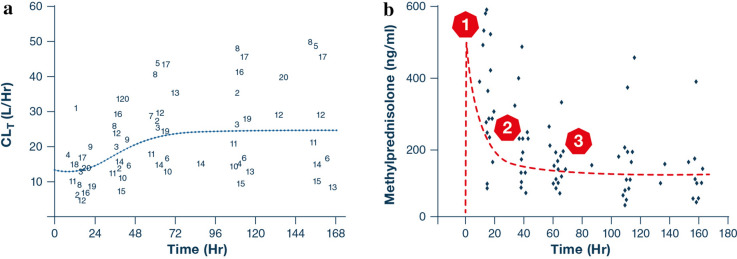Fig. 4.
Methylprednisolone pharmacokinetics in ARDS patients. a Time-dependent increase in methylprednisolone clearance [CLt (L/Hr)] in patients treated with a 1 mg/kg loading dose, followed by a 1 mg/kg/day continuous infusion. The high systemic inflammatory state may be responsible for the impaired methylprednisolone metabolism observed in early ARDS at the beginning of therapy. High levels of pro-inflammatory cytokines are known to inhibit the expression and activity of hepatic drug metabolizing enzymes, including multiple cytochrome P450 isozymes relevant for the metabolism of methylprednisolone. Inflammation resolves progressively during continuous therapy, leading to re-establishment of homeostatic conditions of drug metabolizing enzyme systems. This is reflected by a time-dependent increase in methylprednisolone clearance. It took about 2 days (41.1 h) of methylprednisolone therapy to achieve 50% of the improvement in clearance towards the re-establishment of homeostasis.[34]. b Methylprednisolone plasma concentration–time profile in ARDS patients receiving the aforementioned dosing regimen. Methylprednisolone clearance is impaired during time period 1 and its concentrations are high enough to trigger genomic and non-genomic GC effects. This most likely establishes initial control of the generalized inflammatory state [33]. Inflammatory control is at least partially established during period 2 within 2 days of therapy, leading to an increased hepatic methylprednisolone clearance, secondary to re-established drug metabolizing activity. The concentrations are maintained around 203 ± 147 ng/mL during period 3, exerting prolonged sustained anti-inflammatory activity.
Reproduced with permission from Yates et al. [34]. Importantly, ARDS patients receiving similar GC doses experience a substantial variability in the resulting plasma concentrations due to between-patient variability; this may affect nati-inflammatory response to treatment

